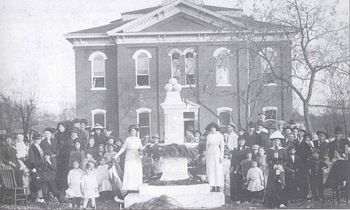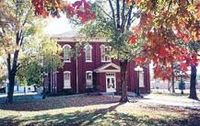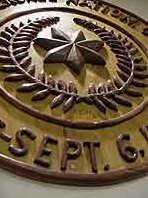
 |
 |
 |
 |
 |
 |
Please help
keep
the heritage alive
with a DONATION
ContentsHistory, continuedNot all of the eastern Cherokees were removed on the Trail of Tears. William Holland Thomas, a white store owner and state legislator from Jackson County, North Carolina helped over 600 Cherokee from Qualla Town (the site of modern-day Cherokee, North Carolina) obtain North Carolina citizenship. As such, these citizens were exempt from forced removal to the west. In addition, over 400 other Cherokee hid from Federal troops in the remote Snowbird Mountains of neighboring Graham County, North Carolina, under the leadership of Tsali[1] (the subject of the outdoor drama Unto These Hills held in Cherokee, NC). Together, these groups were the basis for what is now known as the Eastern Band of Cherokees. Out of gratitude to Thomas, these Western North Carolina Cherokees served in the Civil War as part of Thomas' Legion. Thomas' Legion consisted of infantry, cavalry and artillery. The legion mustered approximately 2,000 men of both Cherokee and white origin, fighting primarily in Virginia, where their battle record was outstanding[2]. Thomas' Legion was the last Confederate unit in the eastern theater of the war to surrender after capturing Waynesville, North Carolina on May 9, 1865. They agreed to cease from hostilities on the condition of being allowed to retain their arms for hunting. This, coupled with Stand Watie's surrender of western forces on July 23, 1865, gave the Cherokees the distinction of being the very last Confederates to capitulate in both theaters of the American Civil War.
In Oklahoma, the Dawes Act of 1887 broke up the tribal land base. Under the Curtis Act of 1898, Cherokee courts and governmental systems were abolished by the US Federal Government. These and other acts were designed to end tribal sovereignty to pave the way for Oklahoma Statehood in 1907. The Federal government appointed chiefs to the Cherokee Nation, often just long enough to sign a treaty. However, the Cherokee Nation recognized it needed leadership and a general convention was convened in 1938 to elect a Chief. They choose J. B. Milam as principal chief, and as a goodwill gesture Franklin Delano Roosevelt confirmed the election in 1941.
W. W. Keeler was appointed chief in 1949 but as federal government adopted the self-determination policy, the Cherokee Nation was able to rebuild its government and W. W. Keeler was elected chief by the people, via a Congressional Act signed by President Nixon. Keeler, who was also the President of Phillips Petroleum was succeeded by Ross Swimmer, Wilma Mankiller, Joe Byrd and Chad Smith who is currently the chief of the Nation. The United Keetoowah Band took a different track than the Cherokee Nation and received federal recognition after the Indian Reorganization Act of 1934. They are descended from the Old Settlers, or Cherokees that moved west before Removal, and the tribe requires a quarter blood quantum for enrollment. The Modern Cherokee Nation
The modern Cherokee Nation (referred to as "The Cherokee Nation of Oklahoma" in its constitution[3]) in recent times has excelled and has experienced an uprecedented expansion in economic growth, equality, and prosperity for its citizens under the leadership of Principal Chief Chad Smith, with significant business, corporate, real estate, and agricultural interests, including numerous highly profitable casino operations. The Cherokee Nation controls Cherokee Nation Enterprises, a very large Defense contractor that creates thousands of jobs in Eastern Oklahoma for Cherokee Citizens. The Nation has constructed health clinics throughout Oklahoma, contributed to community development programs, constructed learning facilities and universities for its citizens, instilled the practice of Gadugi and self-reliance in its citizens, revitalized language immersion programs for its children and youth, and is a powerful and positive economic and political force in Eastern Oklahoma.
|
 The Cherokee Nation hosts a National Holiday in early September each year and 80,000 to 90,000 Cherokee Citizens travel to Tahlequah, Oklahoma each year for the festivities. The Cherokee Nation also publishes the Cherokee Phoenix, a tribal newpapers which has operated continuously since 1828, and publishes editions in both English and the Sequoyah Syllabary. The Cherokee Nation hosts and sponsors historic foundations concerned with the preservation of Cherokee Culture, including the Cherokee Heritage Center which hosts a reproduction of an ancient Cherokee Village which is open to the public. The Cherokee Heritage Center has numerous museum exhibits which is also open to the public. The Cherokee Nation also supports the Sundance and Cherokee Film Festivals in Tahlequah, Oklahoma and Park City, Utah, and provides programs and resources for Native American film makers to particpate in the motion picture industry. Many famous Native American actors are members of the Cherokee Nation, such as Wes Studi. |
The EnvironmentToday the Cherokee Nation is a leader in the environmental protection field. Since 1992 the Nation has served as the lead for the Inter-Tribal Environmental Council (ITEC).The mission of ITEC is to protect the health of Native Americans, their natural resources, and their environment as it relates to air, land, and water. To accomplish this mission ITEC provides technical support, training and environmental services in a variety of environmental disciplines. Currently, there are thirty-nine (39) ITEC member tribes in Oklahoma, New Mexico, and Texas. Cherokee Freedmen Membership Controversies
On March 7, 2006, the Cherokee Nation announced that the Cherokee Freedmen, the descendents of African Americans who were Citizens of the Cherokee Nation and who were adopted into the tribe after the Civil War, are now eligible for membership as Cherokee Citizens because they were classified by the Federal Government as Indians by being entered on the Dawes Commission Lands rolls during the early 1900s [4]. The Cherokee in ancient times did not view a person's race as relevant regarding adoption into Cherokee Society, and historically viewed the Cherokee Society as a politically rather than racially based organization. The Cherokee Freedmen, due to intermarriage with the Cherokee, are for the great majority also of Cherokee Blood and ancestry. There are many exceptionally talented Cherokee artisans of Freedmen descent who currently reside within the Cherokee Nation. The Cherokee Freedmen suffered many of the same hardships as other Indian groups because of their Cherokee Citizenship at the turn of the century and were viewed by the Federal Government as Indians, which led to the freedmen being placed on the Dawes Commission Rolls as Cherokee Citizens during the early 1900's. Many Cherokee traditionalists have opposed granting tribal membership to the Freedmen; however, the Cherokee Nation also grants membership to Indians of Delaware Blood based upon previous treaties and agreements with the United States. The Cherokee Nation Supreme Court recognized the unique role of the Freedmen in Cherokee history and the mutual hardships and common experience with the Cherokee People during pre-Oklahoma Statehood in rendering its decision, and upheld the Cherokee Nation Constitution guarantees of equal rights for all Cherokee Indians. The Principal Chief of the Cherokee Nation recently announced that due to issues raised by the Cherokee People that the issue on the membership of the Freedmen was currently being considered for a vote regarding proposed ammendments to the Cherokee Nation Constitution. These amendments are intended to restrict tribal membership exclusively to Cherokee's by blood descent and exclude the Freedman from Tribal Membership [[5]]. Currently, The Cherokee Nation Constitution restricts who may or may not serve as an elected official only to those persons who are of Cherokee Blood. Some Cherokee traditionalists do not share the views of the Cherokee Nation Supreme Court that the Freedman descendants contributed to Cherokee culture and society in modern times, and oppose granting the Freedmen membership in the Cherokee Nation. Other traditionalists have asserted that Freedmen have an important and rightful place in the CNO. |



